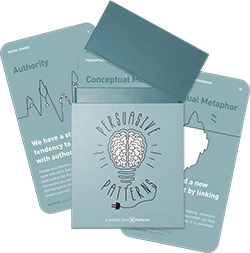Sequencing
Design Pattern
Problem summary
Break down complex tasks into small and easily completed actions
Usage
- Use to help users complete complex tasks
- Use to make more users complete a process
- Use to create a tunnel, focusing the users attention on just what is necessary to complete a task
This card is part of the Persuasive Patterns printed card deck
The Persuasive Patterns Card Deck is a collection of 60 design patterns driven by psychology, presented in a manner easily referenced and used as a brainstorming tool.
Get your deck!Solution
Break down complex tasks into small and easily completed actions, and set expectations as to how many steps are left before the entire sequence has been completed.
- Split up complex tasks. Lower the cognitive load needed to complete complex tasks by breaking them down into small, easily completed actions that are steps in a sequence or simply a list of items that need to be completed to advance through the system.
- Set clear objectives for subtasks. Each subtask should be specified in terms of objectives so that the whole area of interest is covered.
- Set expectations. Set expectations as to how many steps are left before the entire sequence has been completed.
- Remove what is not needed. As you break down a complex task, take note of what users need to do, what the system can do, and what information the user needs. Sequencing into multiple steps allows for conditioning the content shown depending on earlier input, potentially helping to remove steps previously deemed necessary.
Rationale
It is easier to take action when complex activities are broken down into smaller and more manageable tasks. Our working memory has limited capacity that can temporarily hold the information needed for reasoning and the guidance of decision-making.
In the 1960s, reasearch began emerging on the topic of working memory and its effect on decision making. In product design, the UX discipline of Task Analysis is concerned with splitting up complex tasks into more managable bits.
1 Pribram, Karl H.; Miller, George A.; Galanter, Eugene (1960). Plans and the structure of behavior. New York: Holt, Rinehart and Winston. pp. 65
2 Crandall, B., et. al. (2006). Working Minds: A Practitioner’s Guide to Cognitive Task Analysis<. MIT Press.
3 How to improve your UX designs with Task Analysis
4 Working memory at Wikipedia.org
5 The Sequencing technique at Learning Loop
User Interface Design Patterns
- Forms
- Explaining the process
- Community driven
- Tabs
- Jumping in hierarchy
- Menus
- Content
- Gestures
- Tables
- Formatting data
- Images
- Search
- Reputation
- Social interactions
- Shopping
- Increasing frequency
- Guidance
- Registration
Persuasive Design Patterns
- Loss Aversion
- Other cognitive biases
- Scarcity
- Gameplay design
- Fundamentals of rewards
- Gameplay rewards
